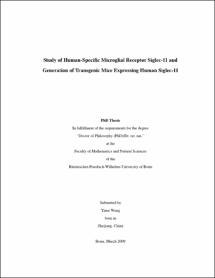Wang, Yiner: Study of Human-Specific Microglial Receptor Siglec-11 and Generation of Transgenic Mice Expressing Human Siglec-11. - Bonn, 2009. - Dissertation, Rheinische Friedrich-Wilhelms-Universität Bonn.
Online-Ausgabe in bonndoc: https://nbn-resolving.org/urn:nbn:de:hbz:5N-18095
Online-Ausgabe in bonndoc: https://nbn-resolving.org/urn:nbn:de:hbz:5N-18095
@phdthesis{handle:20.500.11811/4097,
urn: https://nbn-resolving.org/urn:nbn:de:hbz:5N-18095,
author = {{Yiner Wang}},
title = {Study of Human-Specific Microglial Receptor Siglec-11 and Generation of Transgenic Mice Expressing Human Siglec-11},
school = {Rheinische Friedrich-Wilhelms-Universität Bonn},
year = 2009,
month = jul,
note = {Siglec-11 is a recently identified human-specific CD33-related Siglec expressed on microglia. The full-length cDNA of Siglec-11 encodes 5 extracellular Ig-like domains, a single pass transmembrane domain, and a cytosolic tail, which contains ITIMs. In human, histopathology demonstrated the expression of Siglec-11 on tissue macrophages in various tissues, including microglia in brain. We studied Siglec-11 in microglia. A Siglec-11 splice variant, but no full length Siglec-11 was identified in human brain tissue samples. Functional analysis was performed in cultured mouse microglial cells lentivirally transduced with this splice variant of human Siglec-11. Under stimulation with LPS, gene transcription of IL-1β and NOS2 of microglia was reduced after cross-linking of Siglec-11. The Aβ phagocytosis ability was impaired in Siglec-11 expressing microglia. PSA-NCAM as a putative ligand of Siglec-11 was detected on microglia and neurons. Co-culture of microglia expressing Siglec-11 and neurons demonstrated neuroprotective function of Siglec-11. Neurite density and neuronal cell body density were higher in co-cultures with Siglec-11 expressing microglia than those of control co-cultures. Neuroprotective effect was dependent on sialic acid residues on neurons, but independent on polysialylated residues of microglia. Transgenic mice were generated expressing Siglce-11 under the microglial Iba1-promoter. Chimeric mice were obtained from aggregation of genetically modified ES cells and embryos, but no germline transmission was achieved. Germline transmission was obtained from pronuclear injection of Siglec-11 DNA. Several strains of transgenic mice expressing Siglec-11 in the brain have been sucessfully established. Thus, data show that Siglec-11 is an inhibitory receptor of microglia that might help to create an immunosuppressive milieu in the CNS and alleviate microglial neurotoxicity. Humanized transgenic mice expressing Siglec-11 we have generated serve as a good model to provide valuble information on the natural features of Siglec-11.},
url = {https://hdl.handle.net/20.500.11811/4097}
}
urn: https://nbn-resolving.org/urn:nbn:de:hbz:5N-18095,
author = {{Yiner Wang}},
title = {Study of Human-Specific Microglial Receptor Siglec-11 and Generation of Transgenic Mice Expressing Human Siglec-11},
school = {Rheinische Friedrich-Wilhelms-Universität Bonn},
year = 2009,
month = jul,
note = {Siglec-11 is a recently identified human-specific CD33-related Siglec expressed on microglia. The full-length cDNA of Siglec-11 encodes 5 extracellular Ig-like domains, a single pass transmembrane domain, and a cytosolic tail, which contains ITIMs. In human, histopathology demonstrated the expression of Siglec-11 on tissue macrophages in various tissues, including microglia in brain. We studied Siglec-11 in microglia. A Siglec-11 splice variant, but no full length Siglec-11 was identified in human brain tissue samples. Functional analysis was performed in cultured mouse microglial cells lentivirally transduced with this splice variant of human Siglec-11. Under stimulation with LPS, gene transcription of IL-1β and NOS2 of microglia was reduced after cross-linking of Siglec-11. The Aβ phagocytosis ability was impaired in Siglec-11 expressing microglia. PSA-NCAM as a putative ligand of Siglec-11 was detected on microglia and neurons. Co-culture of microglia expressing Siglec-11 and neurons demonstrated neuroprotective function of Siglec-11. Neurite density and neuronal cell body density were higher in co-cultures with Siglec-11 expressing microglia than those of control co-cultures. Neuroprotective effect was dependent on sialic acid residues on neurons, but independent on polysialylated residues of microglia. Transgenic mice were generated expressing Siglce-11 under the microglial Iba1-promoter. Chimeric mice were obtained from aggregation of genetically modified ES cells and embryos, but no germline transmission was achieved. Germline transmission was obtained from pronuclear injection of Siglec-11 DNA. Several strains of transgenic mice expressing Siglec-11 in the brain have been sucessfully established. Thus, data show that Siglec-11 is an inhibitory receptor of microglia that might help to create an immunosuppressive milieu in the CNS and alleviate microglial neurotoxicity. Humanized transgenic mice expressing Siglec-11 we have generated serve as a good model to provide valuble information on the natural features of Siglec-11.},
url = {https://hdl.handle.net/20.500.11811/4097}
}






